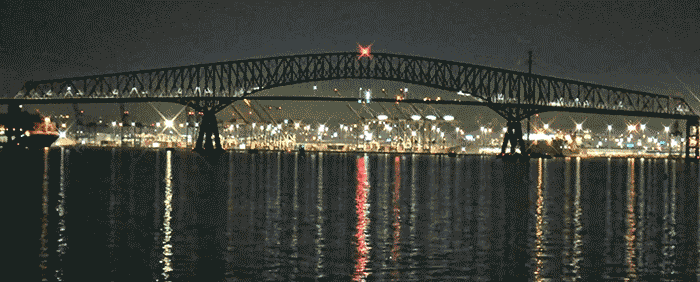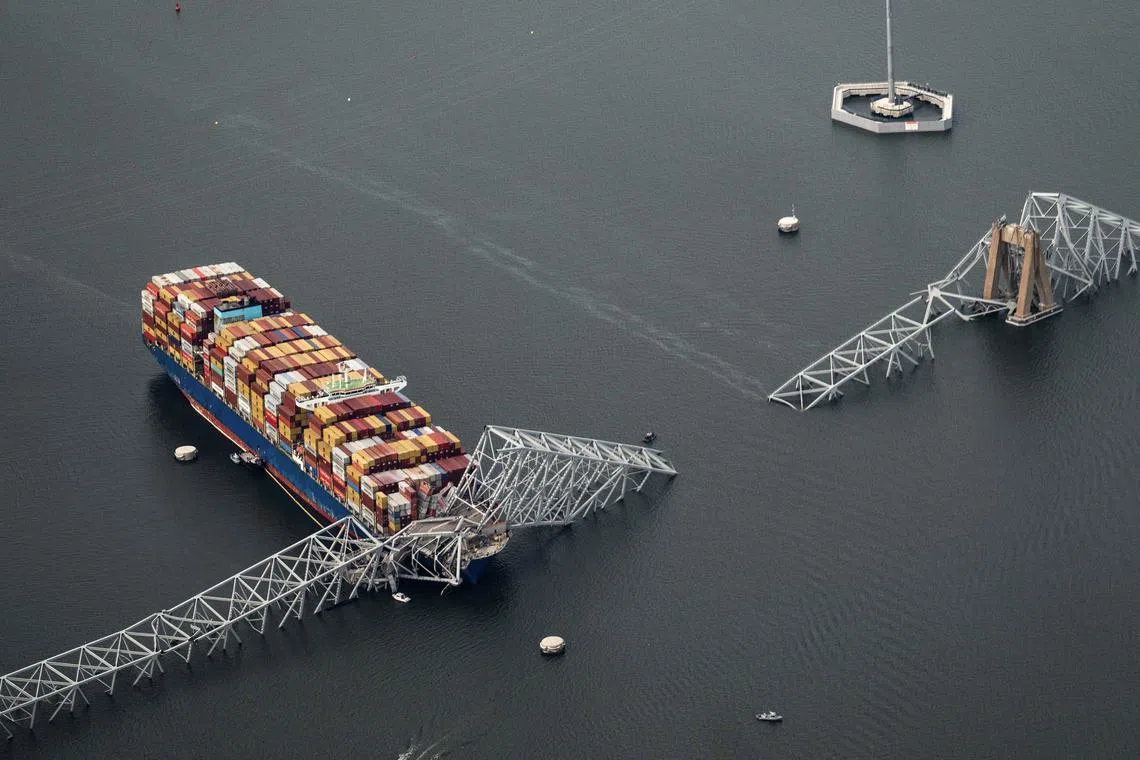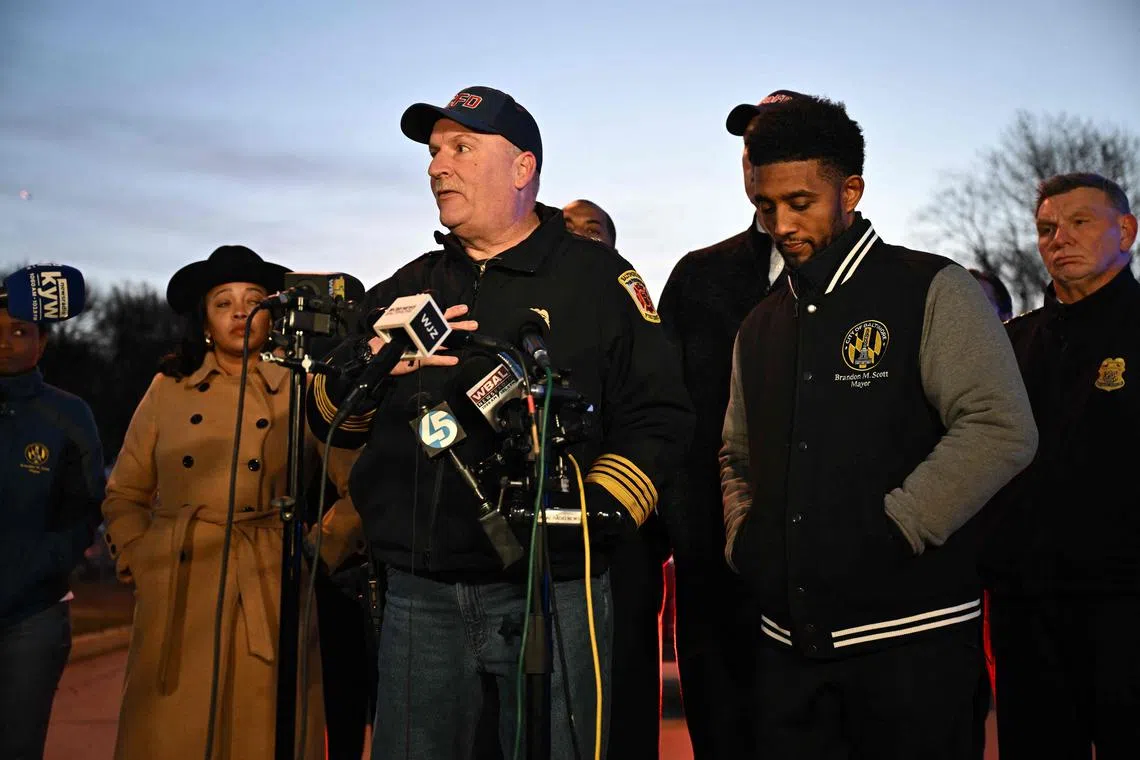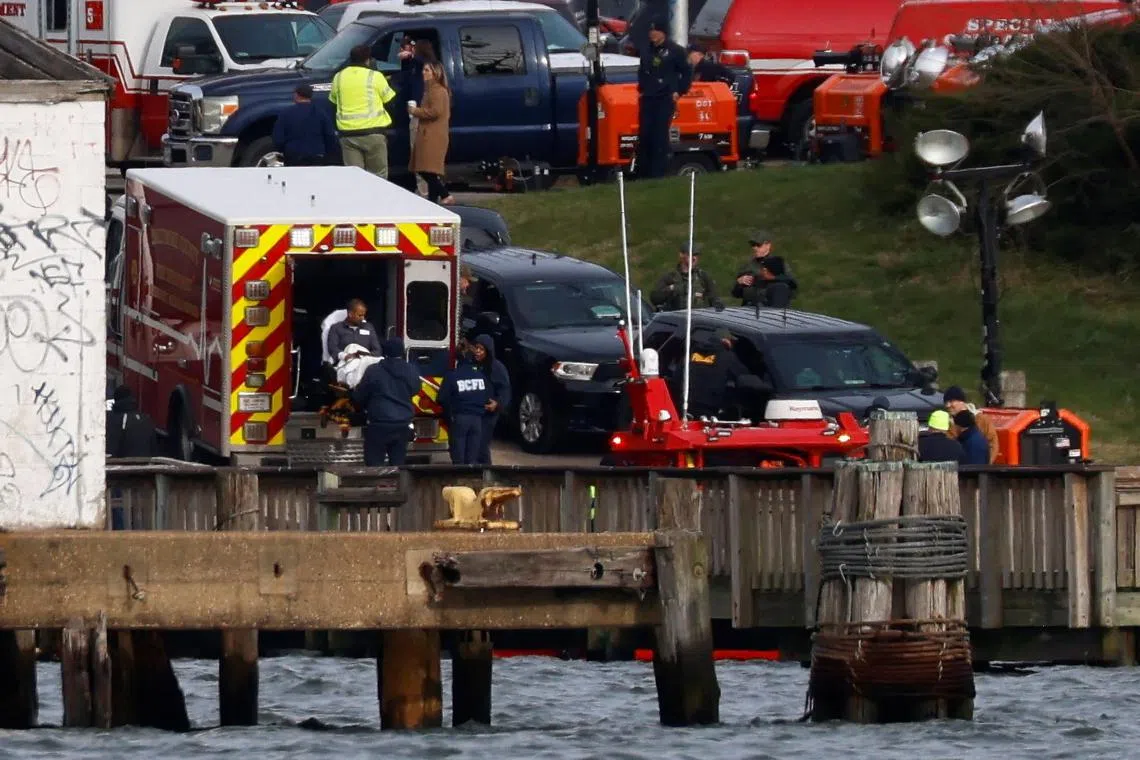Baltimore bridge collapses after S’pore-flagged ship crash; MPA to assist in investigations
Sign up now: Get ST's newsletters delivered to your inbox
Follow topic:
BALTIMORE – A container ship smashed into a four-lane bridge in the US port of Baltimore in darkness on March 26, causing it to collapse and sending cars and people plunging into the river below.
Rescuers pulled out two survivors, one in a “very serious condition” and the other uninjured, and were searching for more in the Patapsco River after huge spans of the 2.6km Francis Scott Key Bridge crumpled into the water.
Eight people were on the bridge at the time of the crash and six remain unaccounted for, said Maryland’s transportation secretary.
The ship “lost propulsion” as it was leaving port, and the crew on board notified Maryland officials that it had lost control of the vessel, ABC News reported, citing an unclassified US intelligence report.
“The vessel notified Maryland Department of Transportation that they had lost control of the vessel and a (crash into) the bridge was possible,” the Cybersecurity and Infrastructure Security Agency was quoted saying. “The vessel struck the bridge causing a complete collapse.”
The ship was identified as a Singapore-flagged container ship, the Dali.
The registered owner of the ship is Grace Ocean and the manager is Synergy Marine Group.
The Maritime and Port Authority of Singapore (MPA) said in response to The Straits Times’ queries that it has contacted the US Coast Guard, the Office of Marine Safety and the National Transportation Safety Board to offer assistance as the flag administration, adding that investigators from Singapore’s Transport Safety Investigation Bureau and MPA are headed to Baltimore to support investigations.
Ship manager Synergy reported that just before the crash, the Dali experienced a “momentary loss of propulsion” and was unable to maintain its desired direction and crashed into the bridge, said MPA.
The Dali dropped its anchors as part of the vessel’s emergency procedures before the crash, added MPA. The ship was under pilotage during the incident, meaning a pilot was on hand to navigate the vessel.
The ship is currently keeping its position at the crash site and is in a stable condition, while all 22 crew members are safe and accounted for as the US authorities’ search and rescue efforts continue.
Baltimore officials said at least seven vehicles plunged into the water but could not give an exact figure.
Baltimore City Fire Department spokesman Kevin Cartwright earlier told Reuters that as many as 20 people could be in the river along with “numerous vehicles, and possibly a tractor-trailer or a vehicle as large as a tractor-trailer, (that) went into the river”.
“This is a mass-casualty, multi-agency event,” he said. “This operation is going to extend for many days.”

The US Coast Guard reported the collapse at 1.27am and crews were deployed for an active search and rescue mission after the Singapore-flagged container ship forced the trellis-like bridge up into a mangled mass of metal.
Water temperatures were around 9 deg C, narrowing the window of survivability.
President Joe Biden was being briefed on the crash and there was no indication of nefarious intent, the White House said.
Work crews had been on the bridge at the time of the collapse and sonar detected vehicles under the water, which was about 15m deep at that point, said Maryland Secretary of Transportation Paul Wiedefeld.

The moment the container ship smashed into the bridge.
STRAITS TIMES GRAPHICS
Ms Jayme Krause was in the midst of another night shift at her workplace on shore when the cart of packages in front of her shook violently at around 2am. A co-worker told her the bridge had collapsed and she ran out to look.
“I went over there, and sure as anything, it was gone. The whole bridge was just like, there was nothing there,” she said. “It was a shocking sight to see.”
Maryland Governor Wes Moore declared a state of emergency to quickly deploy federal resources to deal with the emergency.
The ship issued a Mayday call moments before the crash, a move which saved lives as officials halted some road traffic, he said.
The ship, moving at a “rapid” 8 knots, alerted the authorities that it had lost power, prompting officials to rush to limit cars from travelling over the bridge, Mr Moore told reporters.
“These people are heroes. They saved lives last night,” he said, adding that the bridge was up to code and there were no known structural issues.

The Francis Scott Key Bridge resting partially collapsed after a container ship ran into it in Baltimore, Maryland, on March 26.
PHOTO: EPA-EFE
Traffic was suspended at the Port of Baltimore until further notice, Maryland transportation authorities said.
The closure of one of the US East Coast’s major ports threatens to disrupt supplies of goods such as cars, coal and other commodities like sugar.
It could create bottlenecks and increase delays and costs on the north-eastern seaboard, experts say. The port handles the most car imports and is among the largest for coal exports.
The Francis Scott Key bridge is the main thoroughfare for drivers between New York and Washington who seek to avoid downtown Baltimore. It is one of three ways to cross the Baltimore Harbour, with a traffic volume of 31,000 cars per day or 11.3 million vehicles a year.
Synergy Marine Corp said the Dali crashed into one of the pillars of the bridge and that all its crew members, including the two pilots, had been accounted for and there were no reports of any injuries.
The MPA earlier confirmed that a Singapore-registered vessel crashed into the Francis Scott Key bridge at about 1.30pm Singapore Time on March 26.
The Dali is a 95,000 gross tonnage container vessel that had 22 crew onboard at the time of the incident, it said.
It added that as the flag state, MPA will provide full cooperation to the US Coast Guard in its investigations, and will also be investigating the incident.

An aerial view of the cargo ship that hit the Francis Scott Key Bridge in Baltimore, Md. on Tuesday, March 26, 2024.
PHOTO: NYTIMES
Baltimore Mayor Brandon Scott described a scene of twisted metal shooting into the sky. “It was something out of an action movie. It was something you never thought you’d see,” he said.
The Dali was chartered by shipping company Maersk at the time of the accident, the Danish company said.
“We are horrified by what has happened in Baltimore, and our thoughts are with all of those affected,” Maersk said.

Baltimore Fire Department Chief James Wallace (centre) with Mayor Brandon Scott (right) speaking to reporters on the collapse of the Francis Scott Key Bridge on March 26.
PHOTO: AFP
The Dali was set to depart Baltimore early on March 26 and arrive in Colombo on April 22, according to a schedule on Maersk’s website.
The disaster may be the worst US bridge collapse since 2007, when the I-35W bridge in Minneapolis collapsed into the Mississippi River, killing 13.
It is the first major collapse of a bridge from a ship impact in about 40 or 50 years, said Mr David Knight, a specialist at the Institution of Civil Engineers.
A live video posted on YouTube shows the ship ploughing into the bridge in darkness. The headlights of vehicles can be seen on the bridge as it crashes into the water and the ship catches fire.

Members of the U.S. Coast Guard patrol near the cargo ship Dali as it sits in the water after running into and collapsing the Francis Scott Key Bridge on March 26, 2024 in Baltimore, Maryland.
PHOTO: AFP
Baltimore is the busiest US port for car shipments, with the port’s private and public terminals handling 847,158 cars and light trucks in 2023.
The port handles imports and exports for major carmakers, including Nissan, Toyota, General Motors, Volvo, Jaguar Land Rover and the Volkswagen group – including luxury models for Audi, Lamborghini and Bentley.
It also handles farm and construction machinery, sugar, gypsum and coal, according to a Maryland government website.

An injured sailor from Dali cargo vessel is loaded into an ambulance, following the Francis Scott Key Bridge collapse in Baltimore, on March 26.
PHOTO: REUTERS
More than 40 ships remained inside Baltimore port, including small cargo ships, tugboats and pleasure craft, data from ship-tracking and maritime analytics provider MarineTraffic showed. At least 30 other ships had signalled that their destination was Baltimore, the data showed.
The bridge, named after American lawyer and amateur poet Francis Scott Key, author of US national anthem The Star-Spangled Banner, opened in 1977 and cost an estimated US$60.3 million to build. REUTERS
Additional reporting by Lok Jian Wen

